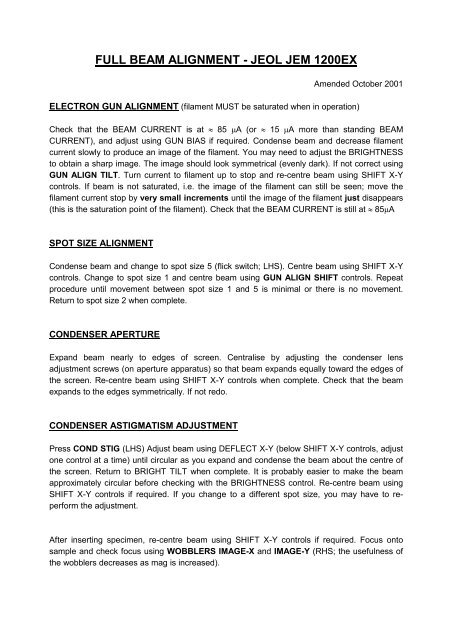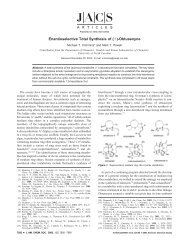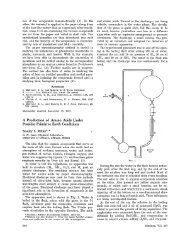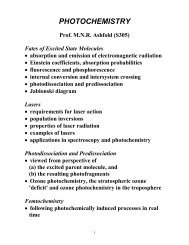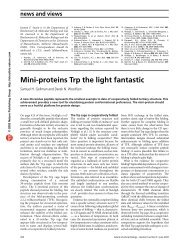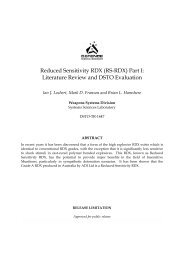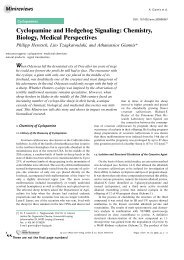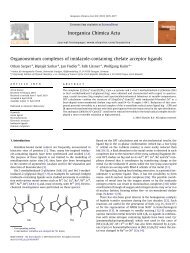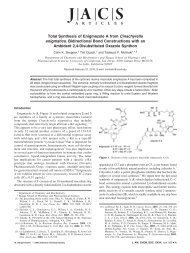FULL BEAM ALIGNMENT - JEOL JEM 1200EX
FULL BEAM ALIGNMENT - JEOL JEM 1200EX
FULL BEAM ALIGNMENT - JEOL JEM 1200EX
You also want an ePaper? Increase the reach of your titles
YUMPU automatically turns print PDFs into web optimized ePapers that Google loves.
<strong>FULL</strong> <strong>BEAM</strong> <strong>ALIGNMENT</strong> - <strong>JEOL</strong> <strong>JEM</strong> <strong>1200EX</strong><br />
Amended October 2001<br />
ELECTRON GUN <strong>ALIGNMENT</strong> (filament MUST be saturated when in operation)<br />
Check that the <strong>BEAM</strong> CURRENT is at ≈ 85 µA (or ≈ 15 µA more than standing <strong>BEAM</strong><br />
CURRENT), and adjust using GUN BIAS if required. Condense beam and decrease filament<br />
current slowly to produce an image of the filament. You may need to adjust the BRIGHTNESS<br />
to obtain a sharp image. The image should look symmetrical (evenly dark). If not correct using<br />
GUN ALIGN TILT. Turn current to filament up to stop and re-centre beam using SHIFT X-Y<br />
controls. If beam is not saturated, i.e. the image of the filament can still be seen; move the<br />
filament current stop by very small increments until the image of the filament just disappears<br />
(this is the saturation point of the filament). Check that the <strong>BEAM</strong> CURRENT is still at ≈ 85µA<br />
SPOT SIZE <strong>ALIGNMENT</strong><br />
Condense beam and change to spot size 5 (flick switch; LHS). Centre beam using SHIFT X-Y<br />
controls. Change to spot size 1 and centre beam using GUN ALIGN SHIFT controls. Repeat<br />
procedure until movement between spot size 1 and 5 is minimal or there is no movement.<br />
Return to spot size 2 when complete.<br />
CONDENSER APERTURE<br />
Expand beam nearly to edges of screen. Centralise by adjusting the condenser lens<br />
adjustment screws (on aperture apparatus) so that beam expands equally toward the edges of<br />
the screen. Re-centre beam using SHIFT X-Y controls when complete. Check that the beam<br />
expands to the edges symmetrically. If not redo.<br />
CONDENSER ASTIGMATISM ADJUSTMENT<br />
Press COND STIG (LHS) Adjust beam using DEFLECT X-Y (below SHIFT X-Y controls, adjust<br />
one control at a time) until circular as you expand and condense the beam about the centre of<br />
the screen. Return to BRIGHT TILT when complete. It is probably easier to make the beam<br />
approximately circular before checking with the BRIGHTNESS control. Re-centre beam using<br />
SHIFT X-Y controls if required. If you change to a different spot size, you may have to reperform<br />
the adjustment.<br />
After inserting specimen, re-centre beam using SHIFT X-Y controls if required. Focus onto<br />
sample and check focus using WOBBLERS IMAGE-X and IMAGE-Y (RHS; the usefulness of<br />
the wobblers decreases as mag is increased).
FOCUSING<br />
Under focusing produces an image with a white fringe. Over focusing produces an image with<br />
a black fringe. At FOCUS neither can be seen and the image is at GAUSIAN FOCUS and has<br />
least contrast (can look out of focus). When taking micrographs the best results are obtained<br />
when very slightly under focus (this varies between different specimens). Focusing on a hole<br />
can help, if you can find them within the close vicinity of the image.<br />
EUCENTRIC HEIGHT ADJUSTMENT<br />
Perform correction at 30K mag and adjust between ± 30° max. Select an isolated object,<br />
centre and focus (use wobbler/s if required). Unlock goniometer hand wheel (push vertical<br />
lever away from you; light goes out), and slowly turn the goniometer. If the image moves<br />
towards the edge of screen, move the image back halfway towards the centre using adjustment<br />
knob on side on goniometer (Z height). Turn the goniometer slowly back to 0°, re-centre image<br />
using translators and re-focus image if required. Perform adjustments until minimal/no<br />
movement of the image is apparent. Lock the goniometer hand wheel (pull vertical lever<br />
towards you) and turn off wobbler/s. Re-centre beam using SHIFT X-Y controls if required.<br />
WOBBLER <strong>ALIGNMENT</strong><br />
It is important that you are at focus and eucentric (on an object) before performing this part of<br />
the alignment, else you will not get enough adjustment of the wobbler alignment controls.<br />
Change mag to ≈ 10 K, condense beam and press the X-IMAGE WOBBLER button (RHS)<br />
Superimpose the images by adjusting the X-controls (underneath keyboard). Repeat for Y-<br />
IMAGE WOBBLER. If the image moves off screen re-centre use the GUN ALIGN SHIFT<br />
controls to re-centre. Re-centre beam using SHIFT X-Y controls if required when complete.<br />
OBJECTIVE APERTURE (increases contrast of sample image; can also be put in place to<br />
prevent/minimise beam damage to sample)<br />
Place OBJECTIVE APERTURE in (lever pointing to left) and expand beam slightly. Centre the<br />
aperture using screw adjusters on objective lens aperture apparatus and return to MAG 1 when<br />
complete. Re-centre beam using SHIFT X-Y controls if required. Going to low mag will help to<br />
locate the aperture if you lose it. The smallest can be the hardest to find if lost (ask EM staff to<br />
help).<br />
SELECTED AREA ADJUSTMENT<br />
Put the SELECTED AREA APERTURE in and centralise using the adjustment screws.<br />
Condense beam and press DIFF (RHS). Focus beam using the DIFF FOCUS control (to
produce the CAUSTIC SPOT; RHS of DIFF button). EXERCISE CARE WHEN LOOKING AT<br />
THE SPOT THROUGH BINOCULARS AS IT IS VERY BRIGHT. Centre beam using<br />
PROJECTOR ALIGN X-Y control knobs (underneath keyboard). Take the SELECTED AREA<br />
aperture out and centre the OBJECTIVE APERTURE around the caustic spot. Return to MAG<br />
1 and re-centre beam using SHIFT X-Y controls if required.<br />
CURRENT CENTRING AND OBJECTIVE WOBBLE<br />
At 40K mag, select an isolated object, focus (focusing onto the edge of the image may help)<br />
and press BRIGHT TILT and OBJ WOBBLE (RHS). Adjust using DEFLECT X-Y controls so<br />
that image appears to expand and contract symmetrically about a central point. Using the small<br />
screen and binoculars may help. Re-centre beam using SHIFT X-Y controls if required.<br />
VOLTAGE CENTRING AND HT WOBBLE<br />
Change to 100K mag. Select an isolated object, focus (focusing onto the edge of the image<br />
may help) press BRIGHT TILT and HT WOBBLE (RHS) . Adjust image using DEFLECT X-Y<br />
controls so that image expands and contracts symmetrically about a central point. Using the<br />
small screen and binocular may help. Turn off BRIGHT TILT and re-centre beam using SHIFT<br />
X-Y controls if required.<br />
ASTIGMATISM OF OBJECTIVE LENS<br />
At low mag e.g. 30K, focus onto an isolated object preferably the edge of a round hole and<br />
gradually work up to approximately 200 - 300K mag. You must be at focus on the carbon<br />
background when you perform this part of the alignment. Using the binoculars, gradually<br />
change the through focus, to focus on the carbon background. Press OBJ 2 (LHS) and adjust<br />
image to minimise streaking using DEFLECT X-Y controls (image should look grainy, or like<br />
wriggling worms). Re-centre beam using SHIFT X-Y controls for brightest image if required.<br />
Some will consider this part of the alignment the most difficult and is a question of practice.<br />
Seek help if you have difficulty.


